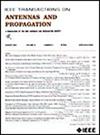Design of Dual-Band Antenna for Metal-Bezel Smartwatches With Negligible Wrist Effects Utilizing Coupled-Feeding Technique
IF 4.6
1区 计算机科学
Q1 ENGINEERING, ELECTRICAL & ELECTRONIC
引用次数: 0
Abstract
Since smartwatches are usually worn on the human wrist, the impact of the wrist on antenna performance (frequency shift and efficiency reduction) is crucial for practical applications. In this communication, a dual-band antenna for metal-bezel smartwatches, which is almost unaffected by the human wrist, is proposed and studied. Unlike traditional smartwatch antenna designs, which directly excite the metal bezel, this work employs a coupled-feeding technique, where the metal bezel is coupled-fed by the coupling metal. The proposed coupled-feeding technique significantly enhances the vertical electric field, making the impact of the wrist on the antenna performance negligible. A prototype demonstrates that, with the coupled-feeding technique, the frequency shift is nearly 0 MHz in the both GPS L1 and Bluetooth (BT) bands. Meanwhile, the efficiency reduction is just 0.3 dB in the GPS L1 band (from −3.8 to −4.1 dB) and 0.2 dB in the BT band (from −3.6 to −3.8 dB). Additionally, with the coupled-feeding technique, the proposed antenna consistently demonstrates stable and reliable performance, whether worn on the left or right wrist or with different coupled-feeding positions. In summary, the proposed antenna, utilizing the coupled-feeding technique, demonstrates slight frequency shift, exceptionally low efficiency degradation, and excellent performance consistency, making it highly promising for practical applications.基于耦合馈入技术的腕部效应可忽略的金属表圈智能手表双波段天线设计
由于智能手表通常戴在手腕上,手腕对天线性能的影响(频移和效率降低)在实际应用中至关重要。在此通信中,提出并研究了一种几乎不受人类手腕影响的金属表圈智能手表的双频天线。与传统智能手表天线设计直接激发金属表圈不同,这项工作采用了耦合馈电技术,其中金属表圈由耦合金属耦合馈电。所提出的耦合馈电技术显著增强了垂直电场,使得手腕对天线性能的影响可以忽略不计。仿真结果表明,采用耦合馈电技术,GPS L1和蓝牙(BT)频段的频移均接近0 MHz。与此同时,GPS L1频段的效率降低仅为0.3 dB(从−3.8 dB降至−4.1 dB), BT频段的效率降低仅为0.2 dB(从−3.6 dB降至−3.8 dB)。此外,通过耦合馈电技术,无论佩戴在左手腕还是右手腕,还是在不同的耦合馈电位置,所提出的天线都表现出稳定可靠的性能。综上所述,该天线采用耦合馈电技术,具有频移轻微、效率衰减极低、性能一致性好等特点,具有较好的实际应用前景。
本文章由计算机程序翻译,如有差异,请以英文原文为准。
求助全文
约1分钟内获得全文
求助全文
来源期刊
CiteScore
10.40
自引率
28.10%
发文量
968
审稿时长
4.7 months
期刊介绍:
IEEE Transactions on Antennas and Propagation includes theoretical and experimental advances in antennas, including design and development, and in the propagation of electromagnetic waves, including scattering, diffraction, and interaction with continuous media; and applications pertaining to antennas and propagation, such as remote sensing, applied optics, and millimeter and submillimeter wave techniques

 求助内容:
求助内容: 应助结果提醒方式:
应助结果提醒方式:


